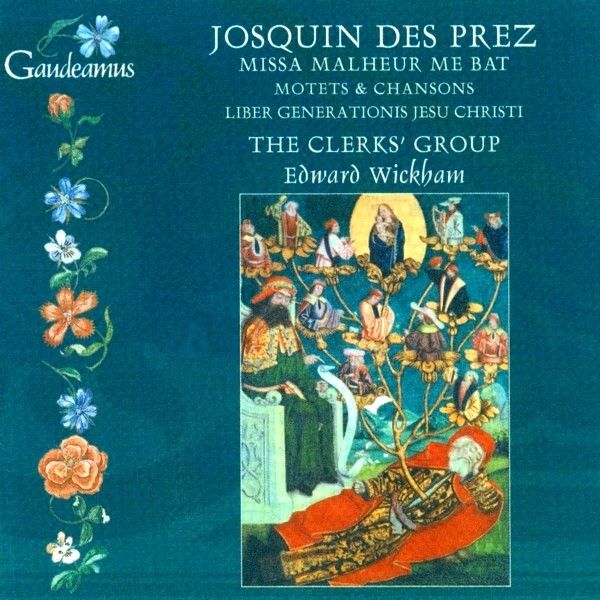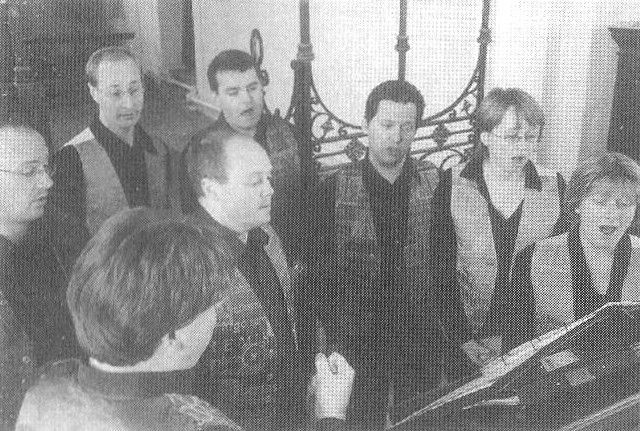JOSQUIN. Missa Malheur me bat / The Clerks' Group
Motets & Chansons · Liber generationis Jesu Christi

medieval.org
AS&V "Gaudeamus" CD GAU 306
2002
JOSQUIN
(c.1455—1521)
From Motetti A (1502)
1. Virgo
prudentissima [2:19]
altos, tenors CW BR, basses EW RM
2. Ave Maria ...
virgo serena [4:56]
sopranos, altos, tenors CW MV, basses EW RM
3. Victimae
paschali laudes [3:39]
altos, tenors CW BR, basses EW RM
From Canti B & C (1502 & 1504)
4. Baisés
moy a4 [1:13]
5. Que vous
madame/In pace [5:12]
alto LB, tenors CW MV, bass EW
6. Comment peult
avoir joye [2:21]
soprano RO, tenors CW MV, bass EW
7. Baisés
moy a6 [2:11]
altos, tenors CW MV, basses EW RM
8. Liber
generationis Jesu Christi [11:45]
altos, tenors CW BR, basses EW RM
Missa Malheur me bat
9. Kyrie [4:23]
10. Gloria [5:40]
11. Credo [7:27]
12. Sanctus & Benedictus [9:58]
altos, tenors CW BR, basses EW RM
13. Agnus Dei [9:34]
altos, tenors CW BR, basses
THE CLERKS' GROUP
Edward Wickham
Carys Lane, Rebecca Outram - soprano
Lucy Ballard, William Missin - alto
Chris Watson, Ben Rayfield, Matthew Vine - tenor
Edward Wickham, Robert Macdonald, Jonathan Arnold - bass
Produced by David Trendell
Recorded by David Wright (Gemini Sound)
Recorded in St. Andrews, West Wratting by kind permission of the Vicar
and P.C.C.
15 March 2001 (tracks 2, 4-7)
4-6 October 2001 (tracks 1, 3, 8-13)
Designed by Studio B, The Creative People
Cover Illustration:
The Tree of Jesse from the Dome Altar, 1499 (tempera on panel)
by Absolon Stumme (15th century),
courtesy of Hamburg Kunsthalle, Hamburg, Germany / Bridgeman Art Library

Missa Malheur me bat is one of Josquin's longest and most
vocally-demanding mass settings, but the inspiration behind it is
modest and unremarkable. Thought to be by the Ferrarese composer
Malcort, the song Malheur me bat survives as music only. The
three words of its title alone hint at a work in which the poet is
tormented by unrequited love, or threatened with financial insolvency,
or both — set to a self-consciously mournful soundtrack. So
coated in Phrygian melancholy is the song that no composer could
possibly touch it without sticking, but the song's clearly-defined
modality may have been part of the attraction to composers such as
Josquin. The song structure must also have generated interest, for here
— as in the similarly-structured and even more popular song Fors
seulement — the tenor and superius imitate one another
(listen to the opening of the Gloria for a closely-related
adaptation): fertile ground for any composer interested in constructing
long passages of close but varied imitation.
From the opening movement of Missa Malheur me bat, it is clear
that Josquin's cycle is to be a substantial and ambitious work. This is
not a Kyrie in which the movements are stylistically
complementary, short vignettes introducing us to the musical ideas
which will be elaborated later in the cycle. Rather, here is — as
it were — a "through-composed" Kyrie: still tripartite,
but a movement in which there is a linear development from one section
to the next. The impression is of the composer meticulously gathering
together and trying out the melodic and harmonic tools with which he is
to build. In Kyrie I he tries out the e to a
cadence, and in the latter part of the Christe he combines this
with the f to e, falling semitone cadence — the
quintessential Phrygian gesture. But the final tool is only properly
introduced in the final section with an emphatic major cadence on C.
Arguably this is the most important tool of all, for it is in the
contrast of major and minor modalities that Josquin so effectively
delineates musical and text paragraphs throughout the mass.
Of course the techniques Josquin uses to explore the song are far more
diverse than merely the alternation of cadential formulae. As in Missa
Fortuna desperata, Josquin has drawn on a variety of methods to
manipulate his chosen material, ranging from the use of a single line
set in long notes in the tenor (as in the first Agnus Dei
section) to something approaching a full-scale "parody" technique.
Josquin is a composer for whom a little can be made to go an extremely
long way and even the simple falling semitone gesture is sufficient to
furnish several bars worth of music, as at the start of the "Qui
tollis" section of the Gloria.
A distinctive feature of Misse Malheur me bat is its treatment
of borrowed material in repeated segments. Though present in other
masses by Josquin, this technique — in which a small portion of
the song is stated and then immediately re-stated at twice the speed
(listen, for example, to the top voice in the first section of the Credo,
or in the final Agnus Dei petition) — is more closely
associated with Josquin's contemporary Jacob Obrecht, himself the
author of a mass on Malheur me bat (recorded by The Clerks'
Group on CD GAU 171). Indeed, it is quite possible that Josquin was
encouraged to compose a cycle on this native Ferrarese song when he was
employed at by Duke Ercole d'Este of Ferrara in 1503-4, just as Obrecht
presumably encountered it during his first period of employment in
Ferrara in the 1480s.
The competitive urge — evidence of which can be found in so many
mass cycles of the early Renaissance — may help to explain the
extraordinary finale to Josquin's Misse Malheur me bat. For the
third petition of the Agnus Dei the bass and contratenor altus
parts split in two and proceed in canon, the elements of which are only
a minim apart. These fast, decorative voice-pairs serve to accompany a
final statement of the song in tenor and superius, the overall effect
being of climactic bravura. As in the final section of his Missa L'homme
armé Sexti toni which closely resembles this movement,
Josquin displays his appreciation for the rhetorical potential of the
final Agnus. Here are movements which are as far from the slow,
meditative Agnus Deis of the later Renaissance as one could
imagine (at least until 18th-century Vienna).
The three motets which open this recording are all to be found in
Petrucci's 1502 collection Motetti... A though it is assumed
that they were composed at least a decade earlier. Each, in miniature,
represents different aspects of Josquin's art: Virgo prudentissima,
built around a simple division into pairs of voices which merge and
re-group; Victimae paschali, more thoroughly involved in the
business of four-voice counterpoint, and perhaps more inventive in its
adaptation of the chant on which it is based; and then Ave Maria .
. . virgo serena, Josquin's most enduringly popular work. A
compact, text-based, strictly and hierarchically imitative work, this
motet still sings with the freedom and lyricism of the finest song or
hymn tunes. The simple variety that Josquin brings to the organisation
of the voices, concluding with a direct, homophonic appeal to Mary
"miserere mei", is at once mysterious and moving.
Curiously, the longest motet in this programme — Liber
generationis — is also concerned with variety and brevity.
Why Josquin should have wanted to set the genealogy of Christ (from the
opening of St Matthew's Gospel) is puzzling, though he enjoyed the
exercise sufficiently to make a similar attempt on the genealogy in St
Luke's Gospel (Factum est autem). The text is liturgical and
might have been sung as part of a formal devotion, but it is possible
that Josquin was drawn to the challenge simply because it suited his
taste for varied repetition. In its avoidance of banality and dullness,
Liber generationis flirts with many styles, including a
playfully madrigalian one as he relishes exotic Old Testament names
such as Zorobabel.
While some of Josquin's works, such as Liber generationis,
might be intended partly as compositional exercises, they rarely sound
stilted. The chanson Baisés moy a4 is constructed from
two pairs of canons in which the voices are set apart by a fourth. This
in itself provides problems of accidental inflection: should the
"following" voice in the canon sing exactly what the "leading" voice
has sung (up a fourth) or should it adapt to harmonic context? The
problems are multiplied in the six-voice version, for which an extra
canonic pair is added to the bottom of the four-voice song. Here the
dilemmas are unresolvable and clashes are inevitable. The result of
this apparently cerebral exercise is a miniature of bittersweet
decadence.
Only the most observant listener would be aware that a canon lies also
at the heart of Comment peult avoir joye, this time at the
octave between superius and tenor. Disguised by the ubiquitous
imitative writing, the canon provides a focal point for a structure
which sounds deceptively unfettered. Que vous madame/In pace,
by contrast, does nothing to disguise its structure with the chant
unusually exposed in the bass voice and rarely participating in the
musical action provided by the upper voices. This motet-chanson is in
the form of a bergerette, and for this performance we have
included the fourth voice, as supplied by Alexander Agricola, in two of
the repeated sections.
© Edward Wickham, 2002



